|
|
|
Theatis 3 ½ x 15 Möller Wedel
The binocular appeared in the market in 1920. It was produced by Möller Wedel Company, in Wedel near Hamburg - Germany.
It was produced two version of that theater glasses. One was painted black and another version was zinc plated in very elegant case.
Technical features:
The binocular is very small;
- only 95 mm (3¾ in) width,
- 50 mm (2 in) height,
- 135 grams (4,8 oz) weight.
The body is built from alloy, only objective tubes are made from brass (Pict 3). It is finished in black color. The black plates on the prism house are missing (Pict 1).
It is binocular with Leman prisms. The most successful binocular with Leman prism system (Pict 4).
Field of view 200 m / 1000 m; in angular measure - 12 degrees.
The focus adjustment, in this binocular, is different from theater glasses described above. It has to be regulated individually in each eyepiece.
The binocular has a specific feature. At the corner of the house prisms there are holes for for looping a decorative tape to suspend the binoculars on the neck.
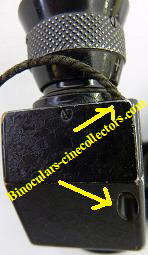 |
The production number 23338, and the company logo is engraved on the internal sides of the house prisms.
Pict 5; Theatis 3 ½ x 15 in our collection; Prod No & Logo
© Anna Vacani
From 1929 the binocular was produced under the same name, but as a part of Zeiss company. That model was central focusing.
|
Pict 1; Theatis 3 ½ x 15 in our collection;
© Anna Vacani
Pict 2; Theatis 3 ½ x 15 in our collection;
© Anna Vacani
Pict 3; Theatis 3 ½ x 15 in our collection; objectives ;
© Anna Vacani
Pict 4; Theatis 3 ½ x 15 in our collection; Leman prism;
© Anna Vacani |
|
|
|
|
|
|
|
|
Busch Winett 3 x 20; Rathenow ca 1910
The binocular was produced in Rathenow, Germany. It was supplied in a very tiny leather pocket pouch - 80 mm long. As the leather was very thin, it is torn on the edges.
Technical features:
The binocular is very small;
- only 65 mm (2 9/16 in) width when folded (Pict. 1), and 120 mm (4¾ in) fully extended (Pict. 2);
- 35 mm (1 9/16 in) height,
- 168 grams (5,9 oz) weight.
The body is built from brass, and ocular tubes are made from nickel plated brass. It is finished in enamel black. The construction body is very unusual as a gate hinge.
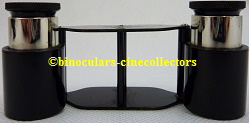 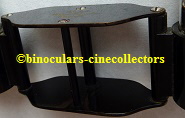
Pict 2,3; Busch Winett 3x20; body © Anna Vacani
It is non-prismatic Galilean binocular. The optical tubes rotates on the body for eye width adjustment.
To adjust focus the ocular must be rotated, on each individual side (Pict. 4).
On the top plate is engraved producer name & information that the Company has applied for patent (Pict. 5, 7). It does not mean it was necessary granted.
The binocular was sold in the UK - Glasgow, Edinburgh, by J. Lizars - very famous optician shop. On the bottom plate is engraved the shop name and address.
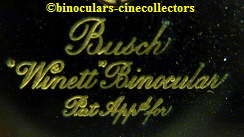 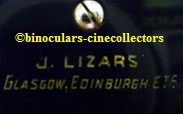
Pict 5, 6; Busch Winett 3x20; top & bottom plate;© Anna Vacani
Being over 100 years old, the binocular is in exceptional condition
|
Pict 1; Busch Winett 3x20; © Anna Vacani
Pict 4; Busch Winett 3x20; focusing © Anna Vacani
Pict 7; Busch Winett 3x20; top plate;© Anna Vacani |
|
|
|
|
|
|
|
|
Beck Kassel CBS 3 1/2 x 26 Carmen, Kassel Germany
The binocular was produced Germany, by Beck Kassel CBS. It is the Company with long history. Christopher Kassel established the company in 1892. It was produced optical instruments - microscopes and binoculars. After the WWI the production concentrated only on the binoculars. During the WWII the manufacture was produced some optical instruments, among them telescopic sites for German Army, with war cod fvx - listed in the list of war time codes book. look in the literature list The company closed its production in 1980s.
The CBS is an abbreviation from - Christopher Beck and Sons.
Technical features:
The binocular is small;
- only 100 mm (3 15/16 in) width;
- 50 mm (1 31/32 in) height,
- 143 grams (5,0 oz) weight.
The body is built from alloy. It is finished in purple enamel . There are leather bands with a purple snake leather pattern around objectives.
It is non-prismatic Galilean binocular. The optics is coated. The binocular is central focusing. Our binocular does not have specified a magnification.
On the left bending arm is engraved Beck Kassel CBS and Carmen on the right arm.

Pict 3; Beck Kassel CBS 3 1/2 x 26; description; © Anna Vacani
On the bottom arm is a description - Made in Germany (Pict 4).
Later, this model has engraved magnification 3 1/2 below the word Carmen.

Presumably the binocular was produced ca. 1958.
|
Pict 1; Beck Kassel CBS 3 1/2 x26 ;in our collection;
© Anna Vacani

Pict 2; Beck Kassel CBS 3 1/2 x 26; top bending bar; in our collection;
Pict 4; Beck Kassel CBS 3 1/2 x 26; objectives; © Anna Vacani
|
|
|
|
|
|
|
|
|
G. Rodenstock München Aldon
The binocular was produced Germany, by G. Rodenstock. It is another Company with long history. Joseph Rodenstock established the company in Wurzburg 1877. In 1882 the Company moved to München. At the beginning the Company produced eyeglasses, lenses and eyeglasses frames. During the WWI, sale of eyeglasses collapsed. The company experienced with binoculars production for army. After the war the company experienced another crises. It begun to manufacturing some lenses for the cameras and next manufacturing own cameras. During the WWII company produced telescopes and prisms sights for tanks. After the WWII Rodenstock developed eyeglasses production.
You can read more about the company, on their web site: http://www.rodenstock.de/rodb2c/de/de/1150066/docId-1149987/Rodenstock/Geschichte/index.html
The company had many foreign sale offices in Europe and USA.
Producing eyeglasses G. Rodenstock produced opera glasses as well.
During the WWII the Company was produced as well and received the war code;
- eso - Optische Werke G. Rodenstock, München, Jsartalstr. 41-43.
Technical features:
The binocular is small;
- only 100 mm (3 15/16 in) width;
- 50 mm (1 31/32 in) height,
- 114 grams (4,02 oz) weight.
The body is built from alloy with chrome trim. It is finished in black enamel . There are leather bands with a black snake leather pattern around objectives.
It is non-prismatic Galilean binocular. The optics is not coated. The binocular is central focusing. Our binocular does not have specified a magnification. Presumably, it is 3 x magnification and objectives 27 mm (Pict 4) - 3 x 27.
The glasses are marked only: G. Rodenstock München on the trim plate of the bending bar, and Aldon on the inside left bending bar arm. (Pict 2,3)
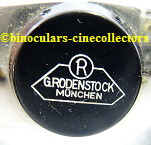
Later on on the washer was engraved Made in Germany, as well.
The binocular was produced in 1950s. Our glasses are in a new condition. The case is not original.(Pict 1)
|
Pict 1; G. Rodenstock Aldon 3 (?) x 27 ;in our collection;
© Anna Vacani
Pict 2; G. Rodenstock Aldon 3 (?) x 27 ;in our collection;
© Anna Vacani
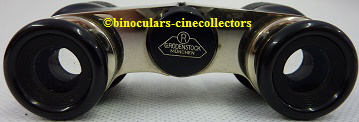
Pict 3; G. Rodenstock Aldon 3 (?) x 27 ;in our collection;
© Anna Vacani
Pict 4; G. Rodenstock Aldon 3 (?) x 27 obj. ;in our collection;
© Anna Vacani |
|
|
|
|
|
|
|
|
ABC Miniature opera glasses
These binoculars are prismatic with Porro I optical system.
This binoculars were very popular in many countries because of the shape, light weight and compactness and optics.
The glasses - Optistar 6x and Fata Morgana 4x, were designed by Alfred Baumann, Cassel Germany. In 1919, he applied for patent in :Germany, USA, French, Swiss and British. He was granted for them - USA - Nov. 15. 1921; French Jan 1921; Swiss June 1922 British Sep. 1920; Germany Feb. 1923.
Alfred Baumann Company was named - Optische Werke Alfred Baumann & Co, but it was not specified on the binoculars. The producer was marked, on glasses as - ABC.
You can read a lot about these binoculars on web site:
http://www.miniaturebinoculars.com/
Not possible to add any more information to these binoculars. The authors of that web site are analyzing every detail and history of these miniature binoculars. You can read the patent’s documents as well, and to see old advertisements.
1. ABC Optistar 6x 17
We have two Optistar binoculars in our collection; No 39186 and 44485.
As we learnt the binocular was advertised as sport, travel and marine binocular, in 1920s.
At the time of manufacture binoculars was subjected to slight changes. It is visible in our two pieces as well.
Technical features of No 39186: (Pict 1,2)
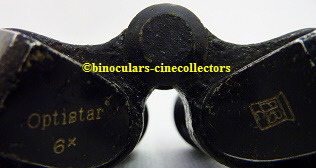
The glass with lower number is a little smaller; the objective tube is shorter. The sunshade is shorter, as well, it is 6 mm long (measurement inside of the hood)
The binocular is small;
- only 95 mm (3 47/64 in) width - over the eyecups;
- 65 mm (2 9/16 in) height,
- 100 grams (3,52 oz) weight.
The body is built from alloy. It is finished in black enamel .The binocular was partly re-painted. The binocular is in the original case.
Technical features of No 44485: (Pict 3)
The sunshade is longer than the glass with lower number, it is 7,5 mm long (inside of the hood). The objective tubes, and objective rings is slightly longer, as well.
- 100 mm (3 15/16 in) width over the eyecups;
- 70 mm (2 3/4 in) height;
- 118 grams (4,16 oz) weight.
The paint of the binocular is partly missing.
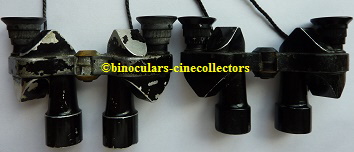
Pict 4; ABC Optistar 6x17, No 44485 - left; No 39186 - right ;in our collection;
© Anna Vacani
2. ABC Fata Morgana 4x 12; prod no 17601 (Pict 4)
This binocular was very popular among the world. It was built in many version, but there were introduced only a small, external differences ,mainly to the eyepieces; ring - vertical or cross hatch knurl. Later models have a pin fitted into rings for focusing the binocular.
Our glasses have cross hatch knurl and the pin on the rings.
Some have fitted the extended handle for theater use and finished in gold. And with telescopic handle finished in black.
Technical features:
The binocular is small;
- only 95 mm (3 47/64 in) width - over the eyecups;
- 40 mm (1 37/64 in) height,
- 79 grams (2,78 oz) weight.
The body is built from alloy. It is finished in black enamel.
|
Pict 1; ABC Optistar 6x17, No 39186 ;in our collection;
© Anna Vacani
Pict 2; ABC Optistar 6 x 17, No 39186; in our collection © Anna Vacani
Pict 3; ABC Optistar 6 x 17, No 44485; in our collection; © Anna Vacani
Pict 4; ABC Fata Morgana, No 17601;
in our collection; © Anna Vacani
|
|
|
|
|
|
|
|
|
Mirakel 5 x 15, Harwix Berlin ca 1928
This binocular was advertise, in N.Y. in 1928, as a “pocket prism binocular, 5 power, 5 ounces, 155 yd. field $ 19.85 ”. In advertisement from 1939 the binocular was priced as $25; It was pointed out that the binocular was good for polar region and desert explorers.
Often, you can find on the internet, that the binocular is 5 x 65. It is a mistake caused by mark “65” number, refers to a spacing of bending bar:
Pict 1; Mirakel 5 x 15; plates & bending bar; © Anna Vacani
The diameter of the objective is 15 mm.
As far as today, we do not know history of the Harwix Berlin Company.
It is unusual, that this small binocular has the production number: 0974, on the binocular washer.
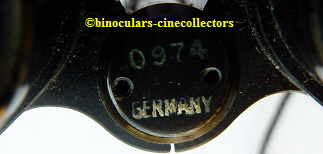
Pict 2; Mirakel 5 x 15; production number; © Anna Vacani
The other body is made of Bakelite with some external parts made of brass: objective rings and eyepiece rings. In the advertisement the body was described as;
“Frame of durable jet-like composition - cannot rust cannot wear”.
The binocular is prismatic with Porro I optical system
Technical features:
The binocular is small;
- only 95 mm (3 47/64 in) width - over the eyecups;
- 55 mm (2.16 in) height, with extended eyepieces;
- 155 grams (5,46 oz) weight.
Our binocular is in very good condition. It is in original case. |
Pict 3; Mirakel 5 x 15; in our collection; © Anna Vacani
Pict 4; Mirakel 5 x 15; in our collection; © Anna Vacani
|
|
|
|
|
|
|
|
|
OIGELET DRP 6 x 17; OIGEE Berlin, 1920s
The binocular was produced by Company OIGEE Berlin. As we have not seen history of the company, we will examine the production of the company and in this way we will create history of the company.
The OIGEE, it is the acronym of company name - Optische Industrie Gesellschaft.
As you probably remember - the DRP description indicates - Deutches Reichpatent (Patent of the German Reich).
In the period of 1905-1918 Oigee produced binoculars for army - D.F. 03 6x Dienstglas - with military code 03. D.F. - Doppelfernrohr -> Double Telescope.
Some models has additional description; D.F. 03 6x Dienstglas U.F -> (= Unteroffizier-Fernrohe) noncommissioned officer binocular.
As Frank Lagorio says: “ OIGEE is best known for the manufacture of airplane scope sights during WWI ad the development of a reflector gun sight for aircraft in 1918.”
The company was famous for telescopic sights for riffles.
In 1938/1939 Yearbook of German hunters is placed an advertisement of OGEE binocular and riflescopes, in which it was stated: “For 30 years, proven best.”
During the WWII the manufacturer received the war code dzl - Optische Anstalt Oigee
G.m.b.H., Berlin-Schöneberg, Bahnstr. 22
At the WWII time OIGEE produced binoculars as well, such as military 6 x 30 - individual focusing (IF);
The company manufactured civilian models of which, often, the first part of the name is “Oige”: Oigesport, Oigelet, etc.
After the war OIGEE produced binoculars : Oigestart 8 x 40, and 6 x 36 Oigejagd - central focus. They were marked as “Made in West Germany”.
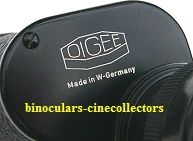
Pict 6; Oigejagd 6x36; © Chris Lackner - collector from London
Both binoculars are coated.
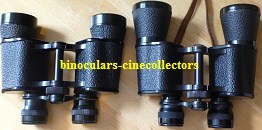
Pict 7; Oigejagd 6x36; 8x40; © Chris Lackner - collector from London
We can see, that the body shape of the binoculars, changed and were produced in a modern style.
Comparing our binocular 6x (Pict 1) to the modern style CF 6 x 36, we cannot to observe any similarities.
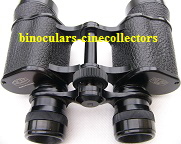 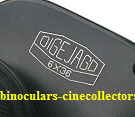
Pict 8; Oigejagd 6x36; © Chris Lackner - collector from London
The central focusing ring is very narrow and placed under oculars bar. In old binocular adjustment was placed between bending arms. As it is focusing the oculars are moving upwards. Doing the same adjustment with our binocular the objectives slide out.
In Victoria and Albert Museum, in London is a poster for Oigee binoculars, created in 1912, by German graphic designer- Lucian Bernhard ( 1883-1972):
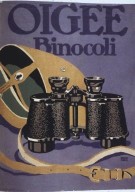
Photo courtesy of Victoria and Albert Museum, in London
The binocular is prismatic with Porro I optical system.
Technical features:
The binocular is small;
- only 100 mm (3 15/16 in) width - over the eyecups;
- 80 mm (3.14 in) height, with extended objectives
- 237 grams (8.35 oz) weight.
Comparing to our other miniature glasses, Oigelet is rather heavy.
The body is built from alloy, with brass parts; top and bottom plates, objective rings, eyepieces rings. The prism house is covered with leather.
The binocular production number is engraved on bottom bending arm - 128033 (Pict 5).
|
Pict 1; Oigelet DRP 6 x 17; in our collection; © Anna Vacani
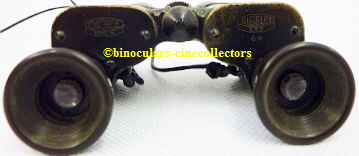
Pict 2; Oigelet DRP 6 x 17; in our collection; © Anna Vacani
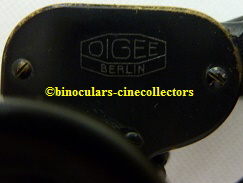
Pict 3; Oigelet 6x17; left plate © Anna Vacani
Pict 4: Oigelet 6x17; right plate © Anna Vacani
Pict 5: Oigelet 6x17; Prod No © Anna Vacani
|
|
|
|
|
|
|
|
|
Turmon 8 x 21 Miniature Field Glass - 1935 & 1970’s
Turmon it is monocular produced by Carl Zeiss Jena after WWI, since 1921.
In the Zeiss catalogue April 1928 edition the Turmon is described: “ [...] the TURMON is little larger than a matchbox and hence may be conveniently accommodated in the waistcoat pocket together with its leather case [...] it is greatly valued by all those who insist on dispensing with any but the absolutely needful encumbrance while touring in high mounting regions or when skiing or flying”
In the Zeiss Field Glasses - June 1931 edition the monocular was described in a similar way.
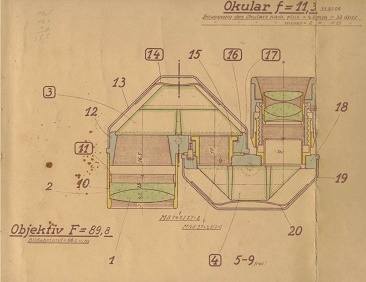
Pict 1; Assembly drawing of the Turmon from 20/05/1924 - Carl Zeiss Documents
The ocular is assembled with 3 elements; one separate and bottom two elements are cemented, the focal length is 11,3.
Two separate Porro prisms, looking to the ocular is a smaller prism than the top prism looking to objective. The prisms are held in place by spring clips.
This model has achromatic cemented objective glass FL 89,8. The prisms in Turmon is a different size than a normal Zeiss binocular. The shape is longer. In this way it is not possible to change the prisms from a Zeiss binocular. If you need a prism replacement you have to take it from another Turmon.
The Turmon was produced for many years after the war, including by Docter Optic Wetzlar Jena in Eisfeld GmbH . It was named Docter 8 x 21 C.
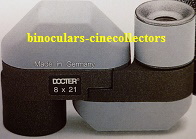
The picture from catalogue Docter Optic Wetzlar Jena July 1995.
Model from 1935:

The technical details from Zeiss catalogue April 1928 edition & 1931 cat is identical table
The price list, included to the above catalogue, it given a price of the Turmon as $24 and the leather case $2.
External features:
The body is built from alloy (prisms housing) and brass (objective and eyepiece tubes) with crinkle black finish. On the right edge of the upper prism housing is monocular description , Zeiss logo and production number. All models before the WWII have production number.
Our monocular has number: 1661823.
This model has a convex outer eye lens.
It is fitted with an adjustable eyepieces and dioptre scale. It can be used as a telescopic magnifier for observing objects at short distance with front lens attachments up to x30 magnification.
Internal Features:
The monocular is prismatic with Porro I optical system (Pict 1). The glasses are uncoated. It gives very sharp and clear picture.
The binocular dimensions:
The monocular is small, the outside dimensions, when extended is only 25.4 mm x 39.69 mm x 63.50 mm (1 x 1 9/16 x 2 1/2 inches).
The weight of monocular is - 99.22 gram (3 1/2 oz).
The monocular is in the original leather case with Carl Zeiss Jena & Made in Germany logo embodied into case (Pict 2)
Model 1970:
This model was built in DDR. In all our Zeiss catalogues a technical description is exactly the same as it was printed in pre-war catalogues. In the price list of June 1963 for London shops it was priced £15.
External features:
The body is built from alloy body with vulcanite covering. The description plate is in the same site as old model. The letters are embodied into a shine plastic oval. At the top of the plate is factory quality stamp. On the metal ring are letters - DDR (Pict 7).
The eye tube is different from before the war model. It is much thinner (Pict 7). This model has a flat lens or very slightly concave.
The weight of monocular is - 86 gram (3 oz).
Internal Features:
The monocular is prismatic with Porro I optical system. The glasses are fully coated.

Pict 8; the coated lens in DDR model; © Anna Vacani
Bibliographic note
The The description was delivered on:
Carl Zeiss catalogues: 1928; 1931; 1950 (DDR edition); 1957; 1960; 1963; 1977; Docter Optic Wetzlar Jena catalogue; all in our collection.
http://www.monocular.info/turmon.htm
http://www.opticsreviewer.com/docter-monocular.html#ixzz3KHfhmKgA
|
Pict 2; Turmon 8x21 with original case - 1935; © A. Vacani
Pict 3; Turmon 8x21 -1935 folded for use; © A. Vacani
Pict 4; Model 1935 Description plate; © Anna Vacani
Pict 5; DDR 1970s with the cardboard box & imitation leather case; © A. Vacani
Pict 6; The DDR model description plate; © A. Vacani
Pict 7; left model 1935, right DDR 1970s;© A. Vacani
|
|
|
|
|
|
|
|
Page Back pages: (1) (2) (3) (4) (5) (6) (7) (8) (8a) (9)
|
|